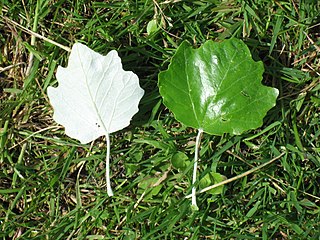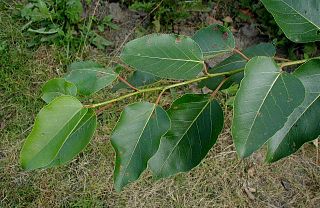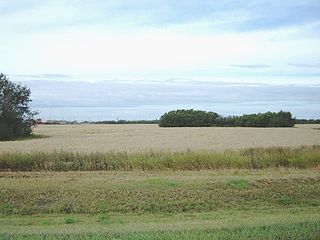
Poplar is a district in East London, England, the administrative centre of the borough of Tower Hamlets. Five miles (8 km) east of Charing Cross, it is part of the East End.

Populus is a genus of 25–30 species of deciduous flowering plants in the family Salicaceae, native to most of the Northern Hemisphere. English names variously applied to different species include poplar, aspen, and cottonwood.

Populus section Populus, of the Populus (poplar) genus, includes the aspen trees and the white poplar Populus alba. The five typical aspens are all native to cold regions with cool summers, in the north of the Northern Hemisphere, extending south at high altitudes in the mountains. The White Poplar, by contrast, is native to warmer regions, with hot, dry summers. These trees are all medium-sized deciduous trees ranging 15–30 metres (49–98 ft) tall.

Blackwall is a Docklands Light Railway (DLR) station in Blackwall area of Poplar in London, England. It is located very close to the northern entrance to the Blackwall road tunnel under the River Thames. The station is on the Beckton branch of the DLR between Poplar and East India stations.

The balsam poplars are a group of about 10 species of poplars, indigenous to North America and eastern Asia, distinguished by the balsam scent of their buds, the whitish undersides of their leaves, and the leaf petiole being round in cross-section. They are large deciduous trees, 30–60 m tall, with leaves with a rounded base, pointed apex, and a whitish waxy coating on the underside of the leaf; this latter distinguishes them from most other poplars. The name is derived from the pleasant balsam smell of the opening buds and leaves in spring, produced by a sticky gum on the buds which also helps protect the buds from insect damage. The balsam poplars are light-demanding trees that require considerable moisture. Poplars are tolerant of very cold conditions, occurring further north than other poplars except for the aspens. The poplars in Southern California are tolerant of 100 plus degree heat. They grow along dry washes and dry riverbed‘s. The dry washes and dry riverbeds will have flowing water when it rains sufficiently. Their leaves hang down and are at an edge to the sun. This may be another factor why they can take the high heat. Their leaves tremble in the slightest breeze like the quaking aspen

Populus alba, commonly called silver poplar, silverleaf poplar, or white poplar, is a species of poplar, most closely related to the aspens. It is native to Morocco and then Spain through central Europe to central Asia. It grows in moist sites, often by watersides, in regions with hot summers and cold to mild winters.
White poplar is a common name used to refer to several trees in the genus Populus:

Aspen parkland refers to a very large area of transitional biome between prairie and boreal forest in two sections, namely the Peace River Country of northwestern Alberta crossing the border into British Columbia, and a much larger area stretching from central Alberta, all across central Saskatchewan to south central Manitoba and continuing into small parts of the US states of Minnesota and North Dakota. Aspen parkland consists of groves of aspen poplars and spruce interspersed with areas of prairie grasslands, also intersected by large stream and river valleys lined with aspen-spruce forests and dense shrubbery. This is the largest boreal-grassland transition zone in the world and is a zone of constant competition and tension as prairie and woodlands struggle to overtake each other within the parkland.

Poplar was a railway station in Poplar, London, that was opened in 1840 by the Commercial Railway and was situated between Millwall Junction and Blackwall, 3 miles 16 chains (5.1 km) down-line from Fenchurch Street. It was closed in 1926, at which time it was owned by the London and North Eastern Railway.

Populus tremuloides is a deciduous tree native to cooler areas of North America, one of several species referred to by the common name aspen. It is commonly called quaking aspen, trembling aspen, American aspen, mountain or golden aspen, trembling poplar, white poplar, and popple, as well as others. The trees have tall trunks, up to 25 meters tall, with smooth pale bark, scarred with black. The glossy green leaves, dull beneath, become golden to yellow, rarely red, in autumn. The species often propagates through its roots to form large clonal groves originating from a shared root system. These roots are not rhizomes, as new growth develops from adventitious buds on the parent root system.

Aspen Island, within Lake Burley Griffin, is a man-made island located in Canberra, Australian Capital Territory, Australia.

Populus tremula, commonly called aspen, common aspen, Eurasian aspen, European aspen, or quaking aspen, is a species of poplar native to cool temperate regions of Europe and Asia, from Iceland and the British Isles east to Kamchatka, north to inside the Arctic Circle in Scandinavia and northern Russia, and south to central Spain, Turkey, the Tian Shan, North Korea, and northern Japan. It also occurs at one site in northwest Africa in Algeria. In the south of its range, it occurs at high altitudes in mountains.

Krogaspe is a municipality in the district of Rendsburg-Eckernförde, in Schleswig-Holstein, Germany. Krogaspe is located north west of Neumünster close to Autobahn A7 and county highway 205 to Rendsburg.

Populus grandidentata, commonly called large-tooth aspen, big-tooth aspen, American aspen, Canadian poplar, or white poplar, is a deciduous tree native to eastern North America.

Aspen is a common name for certain tree species; some, but not all, are classified by botanists in the section Populus, of the Populus genus.
Entoleuca mammata is a species of fungus in the genus Entoleuca. It is responsible for the plant disease hypoxylon canker in hardwood trees such as quaking aspen and other aspens and poplars, Salix myrsinifolia and other willow species, rowan, Sitka alder, birch, apple, oak, and hop-hornbeam.
Anacampsis innocuella, the dark-headed aspen leafroller moth, is a moth of the family Gelechiidae. It was described by Philipp Christoph Zeller in 1873. It is found in North America, where it has been recorded from Alabama, British Columbia, Illinois, Indiana, Maine, Mississippi, New York, Nova Scotia, Ohio, Oklahoma, Ontario, Quebec and Vermont.
Anacampsis niveopulvella, the pale-headed aspen leafroller moth, is a moth of the family Gelechiidae. It was described by Vactor Tousey Chambers in 1875. It is found in North America, where it has been recorded from Alberta, Arizona, British Columbia, California, Indiana, Maine, Manitoba and Ontario.
















